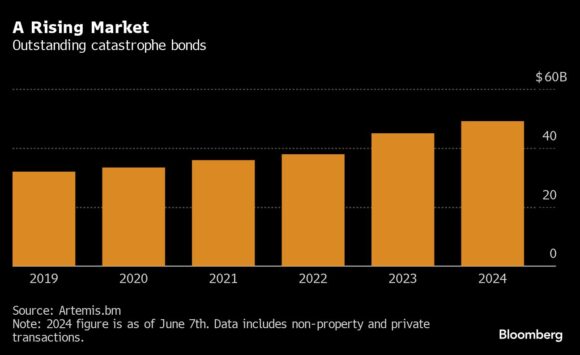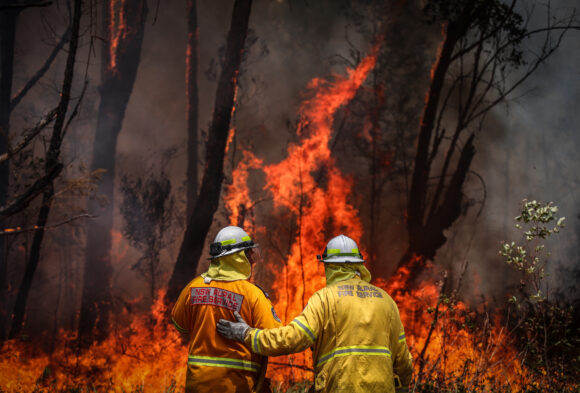The risks from the growing number of natural disasters offer Australia’s largest pension funds a chance to boost returns.
Colonial First State, one of the nation’s biggest pension and wealth managers, is looking to add natural catastrophe reinsurance to its A$151 billion portfolio ($99.5 billion), while rival Insignia Financial Ltd. posted returns of 16% in the category last financial year.
Australia’s fast-growing pensions industry needs to find investment opportunities for the more than A$2 billion of inflows it gets every week. Natural catastrophe reinsurance covers a range of financial products. Catastrophe bonds reward buyers for taking on insurance market risk linked to natural disasters such as hurricanes and earthquakes. If catastrophe strikes, bondholders pay out. If it doesn’t, they stand to reap outsized returns.
Colonial First State Chief Investment Officer Jonathan Armitage said he was looking to provide capital where there is a “natural event risk” such as hurricanes and earthquakes. Investments can be in funds or directly with an insurer to provide capital, he said.
“That sort of market has, first of all, it’s grown significantly in the last 15 years or so, and is properly structured,” he said, adding his focus is on catastrophe bonds in developed markets. The funding will come from other fixed income investments, he said, primarily corporate bonds.
Issuance of catastrophe bonds hit a record high in June, as the market braced for a rough hurricane season with the potential to do substantial damage. Sales of the so-called cat bonds were 38% higher this year through to May than over the same five-month period in 2023, according to Artemis, a compiler of data on insurance-linked securities.

Natural catastrophes caused about $62 billion of insured losses in the first half of 2024 — roughly 70% above the 10-year average — as extreme wildfires, droughts and floods upend historical norms.
“That is a very interesting area to commit capital to, where you can see pretty robust returns,” Armitage said. “As you see more of those events occurring, there is going to be more capital that’s required to support those type of policies.”
The world’s fourth-largest retirement savings pool receives compulsory contributions of the equivalent of 11.5% of workers’ salaries, which will rise to 12% in July next year. About half of the A$3.9 trillion industry is invested offshore, and the industry is highly competitive and heavily scrutinized on its investment performance.
Insignia Financial Ltd.’s pensions business, which oversees about A$180 billion in retirement savings earned about 16% on its investments in the sector last year. Insignia invests in catastrophe bonds, which make up 15-20% of its total exposure to natural catastrophe reinsurance. It also invests in quota shares – the risk sharing of reinsurers balance sheet exposures- and collateralized reinsurance contracts, it said.
“It’s been a really strong year for some of those differentiating asset classes,” MLC Asset Management Chief Investment Officer Dan Farmer said in an interview. Farmer manages the bulk of money in Insignia’s pensions business and MLC is part of the Insignia Financial Group. Part of the appeal of investing in reinsurance is that returns are “very uncorrelated to the rest of the portfolio,” he said.
JANA, which advises institutional investors including pension funds, said more cat bond managers had been visiting Australia to raise money for new or existing funds. “With current spreads elevated, clients have taken the opportunity to either top up existing cat bond holdings or to add new managers,” said Martin Rea, a senior consultant for JANA.
Rea said he held a “positive view” of the cat bond market in the medium term. Still, he said JANA was “tempering our view” of the market in the next 3-6 months due to forecasts of higher-than-normal hurricane activity. Other considerations included catastrophe bond funds being a significant risk to liquidity, and overall strong returns.
“The market has recorded 19 months without a negative return,” Rea said. “We do not think this is sustainable.”
Photograph: A New South Wales (NSW) Rural Fire Service volunteer is given instructions by a colleague as he douses a fire during back-burning operations in bushland near the town of Kulnura, New South Wales, Australia, on Thursday, Dec. 12, 2019. Photo credit: David Gray/Bloomberg
Topics Catastrophe Reinsurance Australia
Was this article valuable?
Here are more articles you may enjoy.



 Georgia Woman Charged with Insurance Fraud After Claimed Injuries
Georgia Woman Charged with Insurance Fraud After Claimed Injuries  Travelers: Costliest Claims Driven by Most Common Workplace Accidents
Travelers: Costliest Claims Driven by Most Common Workplace Accidents  More People Moving In Than Out of Counties With High Catastrophe Risk
More People Moving In Than Out of Counties With High Catastrophe Risk  Hurricane Debby Brings Six Deaths, Widespread Flood Losses in Florida, Georgia, SC
Hurricane Debby Brings Six Deaths, Widespread Flood Losses in Florida, Georgia, SC 

